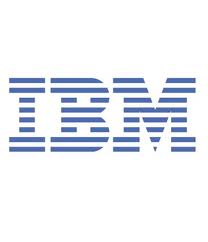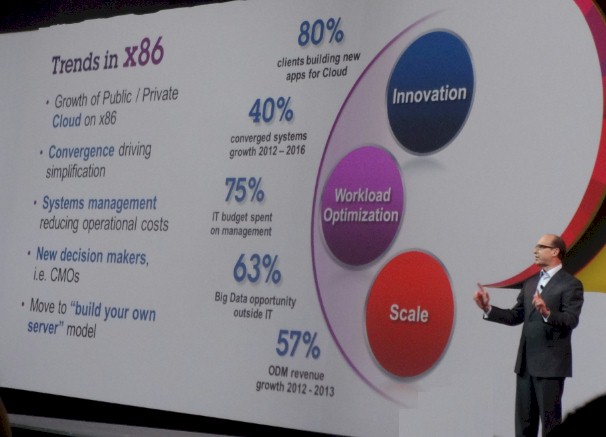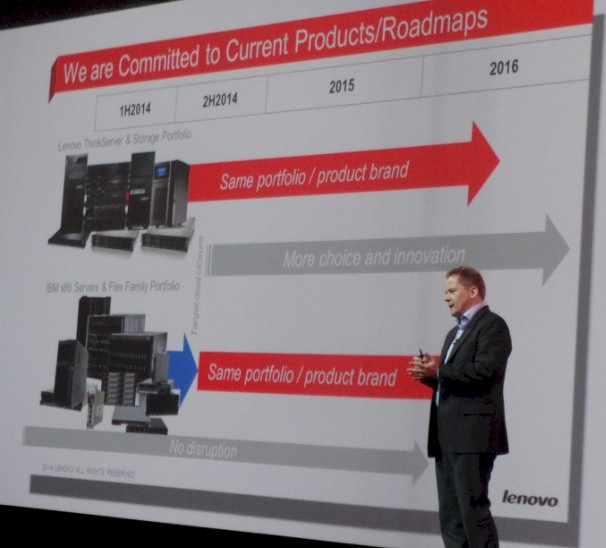IBM X86 Server Deal With Lenovo Is ‘On Track’

IBM and Lenovo Group have said very little about the progress of the $2.3 billion deal that will see the Chinese company take over IBM's X86 server business. But at the Edge 2014 conference hosted by IBM in Las Vegas this week, the company said the deal was on track.
In a keynote address, Adalio Sanchez, general manager of the System x division, who gave EnterpriseTech the scoop on the deal shortly after it was announced in January, could not be precise about how the deal was progressing through the various regulatory bodies of the world. "The deal is on track to close later this year and our aim is to have a seamless transition," Sanchez told the Edge 2014 crowd, which was dominated by customers and business partners in the X86 business.
Speaking to EnterpriseTech before the keynote, Sanchez said that the X86 server divestiture to Lenovo would take a lot less time than the sale of the PC business to the same company a decade ago because Lenovo is a much larger company with a bigger global footprint. Lenovo now has operations in over 100 countries and IBM does business in 160 countries, and the transfer of X86 business units has to occur in each one of them. Lenovo did not have nearly as many operational centers back in late 2004 when the $1.25 billion to acquire IBM's PC business was announced.
The word on the street at the Edge 2014 conference was that IBM and Lenovo wanted to get the deal done by the end of July, but it looks like it may take a bit longer than that. Neither IBM nor Lenovo would comment on such speculation, of course, and stuck to the commitment to try to get the deal done by the end of the year. There are a lot of complexities to the deal because Lenovo is not just buying a product line and a customer base, but is assuming the entire operations of IBM's System x division, including taking on board 7,500 employees who work in this part of the Big Blue. (IBM will keep hold of the System x support personnel and offer tech support on the machines for at least the next five years, and presumably Lenovo will be expanding its own tech support capabilities in parallel.)
The irony at the Edge 2014 conference this week is that the theme is that "infrastructure matters" and the event largely focused on Xeon-based servers from its System x rack servers and Flex System converged system product lines. This might seem a bit incongruous at first. While Big Blue still believes that the underlying infrastructure matters, the company has concluded that it cannot make the margins it needs from the X86 server business.
Lenovo figures that with its much deeper supply chain and lower-cost manufacturing operations it will be able to boost its overall profits by tuning up the System x business that it acquires from Big Blue. And as Sanchez pointed out in a press conference at Edge 2014, the System x business will actually raise profits at Lenovo and be a bright spot for the company rather than being a drag on profits as it was for IBM.
Sanchez said that Lenovo would bring scale to the System x business, something that IBM has been lacking and that therefore made it difficult for the company to compete against Hewlett-Packard and Dell among the tier one server makers and against the upstart original design manufacturers (ODMs) that dominate the hyperscale datacenters of the world.
"The X86 server segment has undergone a massive transformation in the past four years," Sanchez explained in his keynote. The X86 market accounts for 75 percent of server spending and 98 percent of server shipments, and the market has matured and there are a number of disruptive changes affecting the market. The shift to cloud computing – where resources are shared across companies, driving up efficiencies and, in theory at least, driving down costs and providing flexible capacity – is changing who buys systems. In some cases, customers are adopting converged systems, which tightly couple server, switching, and storage into a virtualized complex that is managed by one set of tools, and in other cases, they want minimalist servers because resiliency is now built into the application software and is not needed as much in the operating system and hardware.
To play in this market, any X86 server maker has to do three things, Sanchez added. They have to innovate and they have to create systems that are optimized for specific workloads. This latter item is what is making it difficult for the traditional server makers to compete because they are used to having a dozen or two machines of various sizes that can cover the whole market. But the largest server buyers have not been willing to just buy from the catalog for many years now.
"Everybody wants to be Google, everybody wants to build their own servers," Sanchez said.
The third thing that any X86 server maker needs is tremendous scale. "This means having the maximum procurement cost leverage in a world of rapid commoditization in order to provide clients the best possible costing solutions. This means having nimble, high-volume manufacturing to meet the needs of clients that want customized servers to compete with the ODMs that are emerging in the marketplace. This is what the planned acquisition of our X86 business by Lenovo is all about. Scale was, frankly speaking, our missing link."
Lenovo is a much bigger company today than it was when it closed the deal to acquire IBM's PC business nine years ago, explained Christian Tiesmann, general manger of the global customer commercial business at Lenovo. Back then, IBM had 10,000 employees in its PC business and Lenovo had 10,000 employees of its own. Lenovo shed approximately 5,000 of those IBMers in the years following the acquisition, and it took some time for the company to ramp up sales and take on Hewlett-Packard and Dell in the PC space.
Today, said Tiesmann, Lenovo has over 3,500 engineers in its research and development operations, up from 2,000 engineers eight years ago, and it has over 46,000 employees. The company runs dual headquarters in Beijing, China, and Morrisville, North Carolina, and English is the official language for the company to conduct its business. Legend, the predecessor to Lenovo, was created in part with some funds from the Chinese Academy of Sciences, and Tiesmann said that Google and IBM both have stakes in the company. Lenovo created a new manufacturing operation in the wake of the acquisition that allowed it to compete with HP, Dell, and others, and for the past 20 quarters it has been growing its market share and outgrowing the PC market overall, blowing past HP and Dell to take the number one spot worldwide in terms of PC shipments.
Lenovo's rise in the PC market took a long time, but make no mistake about it: Lenovo wants to do the same thing in servers, and it is willing – and able – to take on the other tier one players and the ODMs to meet its goals.
Exactly how this will be accomplished, Lenovo has not yet said, and it can't really say much until the deal closes. In the meantime, Tiesmann wanted to assure both IBM and Lenovo server customers that the roadmaps for the two companies for the remainder of 2014 are still on track:
Lenovo has a rack and tower business based on X86 machines, with one or two sockets and called the ThinkServers, that are aimed primarily aimed at SMB customers in the emerging markets. The IBM System x and Flex System portfolio will allow Lenovo to have scale-up machines and scale-out clusters that can address the computing needs of large enterprises and traditional supercomputing centers.
"Both companies will do a full product refresh in September as we are going into the next generation of Intel processors, and we will maintain the roadmaps the way they are," Tiesmann said, adding that Lenovo was working with IBM on the storage, switching, and software that goes along with the servers. Lenovo has acquired IBM's switching hardware business as part of the deal as well as Systems Director and other management tools, but Big Blue is keeping its homegrown virtual switch and other management tools. (This could end up being resold or licensed by Lenovo over the long haul.)
It is not clear how far along IBM is with server designs, but presumably it was already working on machines for future "Broadwell" and "Skylake" Xeon processors from Intel. Over time, it is reasonable to expect for Lenovo to converge the ThinkServer and System x racks and towers into one family and to continue development on the Flex Systems because IBM is a captive customer for the iron. Various System x and Flex System machines are the basis of IBM's PureSystems line of appliances, including those branded PureApplication and PureData. But such a convergence doesn't look likely until after 2016, based on the roadmap shown above. And a third prong – the custom machinery that Lenovo has not yet talked about – will also come into play as it chases ODM players in the big datacenters in North America and Asia.
Neither IBM nor Lenovo have said how they will engage in the sale of raw clusters for various kinds of workloads, but Sanchez said that Lenovo would be licensing IBM's Smart Cloud Entry cloud controller as well as its Storwize V7000 disk arrays so it could peddle raw Flex System infrastructure clouds to its customers. Lenovo is also licensing IBM's GPFS file system and Platform Computing cluster management and messaging software and will thus be able to sell scale-out clusters to both enterprises and supercomputing labs.












